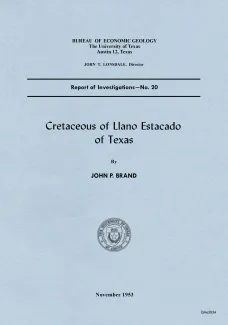
Publication Details
Geolocation:
Get the Publication
$16.00
Abstract/Description:
Rocks of Cretaceous age crop out along the western margins of the deeper playa basins and along the southern and southeastern margins of the Llano Estacado. The Trinity group, containing only the Paluxy sandstone; the Fredericksburg group, consisting of the Walnut, Comanche Peak, Edwards, and Kiamichi formations; and the Washita group, containing only a portion of the Duck Creek formation, have been identified in the Llano Estacado. Formations of the Trinity and Fredericksburg groups are similar lithologically and paleontologically to equivalent units in the Callahan Divide and in the northern edge of the Edwards Plateau. Zonations, applicable to northern and central Texas and Pecos County, Texas, can be extended to the isolated Cretaceous exposures in the Llano Estacado. Cretaceous strata in the Llano Estacado dip to the southeast at the rate of 7 to 8 feet per mile. Structures in the underlying Triassic and Paleozoic do not appear to be reflected in Cretaceous strata. Likewise, the locations of the isolated Cretaceous remnants do not appear to be governed by known structures in underlying units. The Comanche Peak and Edwards limestone and the Kiamichi and Duck Creek shales are chemically suitable for the manufacture of Portland cement. The Edwards limestone is a suitable road ballast material. The sand and gravel of the Paluxy formation could be utilized in concrete aggregate.